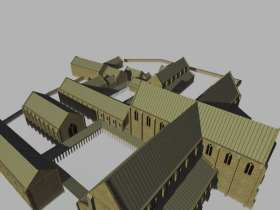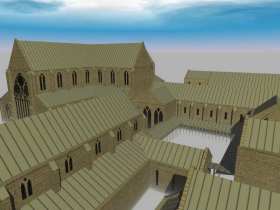
TINTERN ABBEY

A VIEW IN THE PAST...
Tintern Abbey, Church interior - Photo,
Cees Sleven
The
12th century monastery was the first Cistercian house to be founded in
Wales
- the second in the British Isles, after Waverley
in Surrey. From a modest foundation
in 1131, Tintern Abbey was considerably remodelled
and expanded during the next
three hundred years, and it is the vast remains
of this grand, Gothic church that survive
today.
Externally,
the church looks remarkably complete, with the exception of a roof,
and dominates this site which consists of little
more than ground level foundations
marking out the other buildings of the monastic
complex. Although not as long as
some of the great Yorkshire abbeys, the Nave
at Tintern runs to an impressive 228ft
with the majority of Nave columns, and a complete
southern arcade still in existence.

West End
These
imposing,
multi-clustered piers, supporting beautifully moulded arches,
give a feeling of enormous strength and height
to the body of the church.
Much of the decorative work has also survived:
there are sumptuous carvings,
elaborate mouldings, richly detailed roof bosses,
and superb examples of traceried
windows throughout the church.
With
its 'open'
aspect today, devoid of roof, windows and a neatly tiled floor,
Tintern Abbey presents an evocative picture,
especially with sunlight filtering through
the wide arches and casting shadows from the
massive sandstone columns. However,
in medieval times, it would have been equally
spectacular with its stained glass windows
creating rainbow reflections on the red clay
floor tiles, and light radiating from
the brightly painted walls and ceilings.


As
far as the
claustral buildings go, there are only fragmented remains of the once
splendid and important Chapter House, part of
the Sacristy survives, along with its
vaulted ceiling, and a book store with its original
14th century highly decorated doorway.
In the north east corner of the cloister stand
the ruinous walls of the monk' day room,
and evidence of the corbels and octagonal piers
that would once have supported
a vaulted roof. One section of the refectory
wall has survived to show two pairs
of the large, four-light windows with plate tracery
that would have enabled a good deal
of light to shine into this splendid room.
Tintern
did
not appear to suffer unduly from the ravages of war although, in common
with most of the medieval monasteries, financial
difficulties were experienced at times.
However, its fate was decided with the Dissolution,
and in 1536 it was surrendered
to the King. For some 200 years the monastery
was left to decay, and become
forgotten in this remote stretch of the Wye Valley.
Surprisingly, it was with the advent
of a 'tourist' trade in the late Geogian era
that Tintern was rediscovered,
and subsequently restored as a 'romantic attraction'.
A structured
conservation programme was determined in 1901 when the abbey
was purchased by the Crown, and from then on
the continual maintenance and
restoration of the site has been undertaken by
various bodies.


In
common with
so many visitors before me (including the celebrated William
Wordsworth and J M W Turner), when I think of
Tintern I think of beauty, tranquility
and of the wonderful magnetic charm it still
possesses. It is simply magical.
(Source:
The Herritage Trail)
